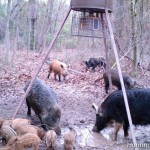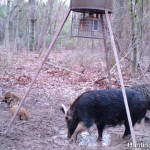Wild hogs, commonly referred to as feral hogs, are simple creatures. The key to hog hunting is to think like a hog. But before doing that, let’s learn a bit more about these clever critters. First, hogs are not native to North America. The first true pigs were brought to the United States by Hernando de Sota to the Atlantic Coast of Florida in 1539. The first Russian wild boars were brought into the Sullivan County, New Hampshire, in 1890 by a fellow named Austin Corbin. And thus, feral hogs in the USA were born.
When it comes to habitat, hogs can make it just about anywhere as long as water and some amount of cover are present. Wild pigs are found in many habitats from woodland, riparian, and marshes to even chaparral and open grasslands. Feral hogs are comfortable on flat to very steep terrain. They are quite mobile, despite they wear the name “pigs.” For the most part, wild hogs are most abundant in woodlands interspersed with grasslands.
Although adaptable in many ways, wild hogs are not everywhere. They do not tend to inhabit very dry areas such as deserts. Hogs also avoid high mountains with substantial winter snowfall. In addition, though they often wreak havoc with farmers and ranchers, wild pigs to not like intensive agricultural areas where screening cover is scarce. However, excellent hog hunting can be had near suitable habitat adjacent these agricultural areas.
Wild hogs are omnivorous and consume a wide variety of available foods, including both plant and animal matter. The feral hog diet is almost limitless, but for the most part their food includes acorns, grasses, forbs, berries, bulbs, tubers, invertebrates, reptiles, birds, eggs, and animal carcasses. Like many wild animals, their diet varies with the season. Wild pigs feed on grasses and forbs in the spring, mast and fruits in the summer and fall, and roots, tubers and invertebrates throughout the year.
As with all animals that are hunted, feral hog behavior tends to change as hog hunting pressure increases. Where hunting rarely occurs, wild pigs are active throughout the day, though they become less active in hot weather. With moderate hunting, hogs will bed up around sunrise and become active again in the late afternoon. When hog hunting pressure is very high wild hogs will only move and feed at night. Although rare, feral hogs will leave an area when hunting pressure becomes severe.

